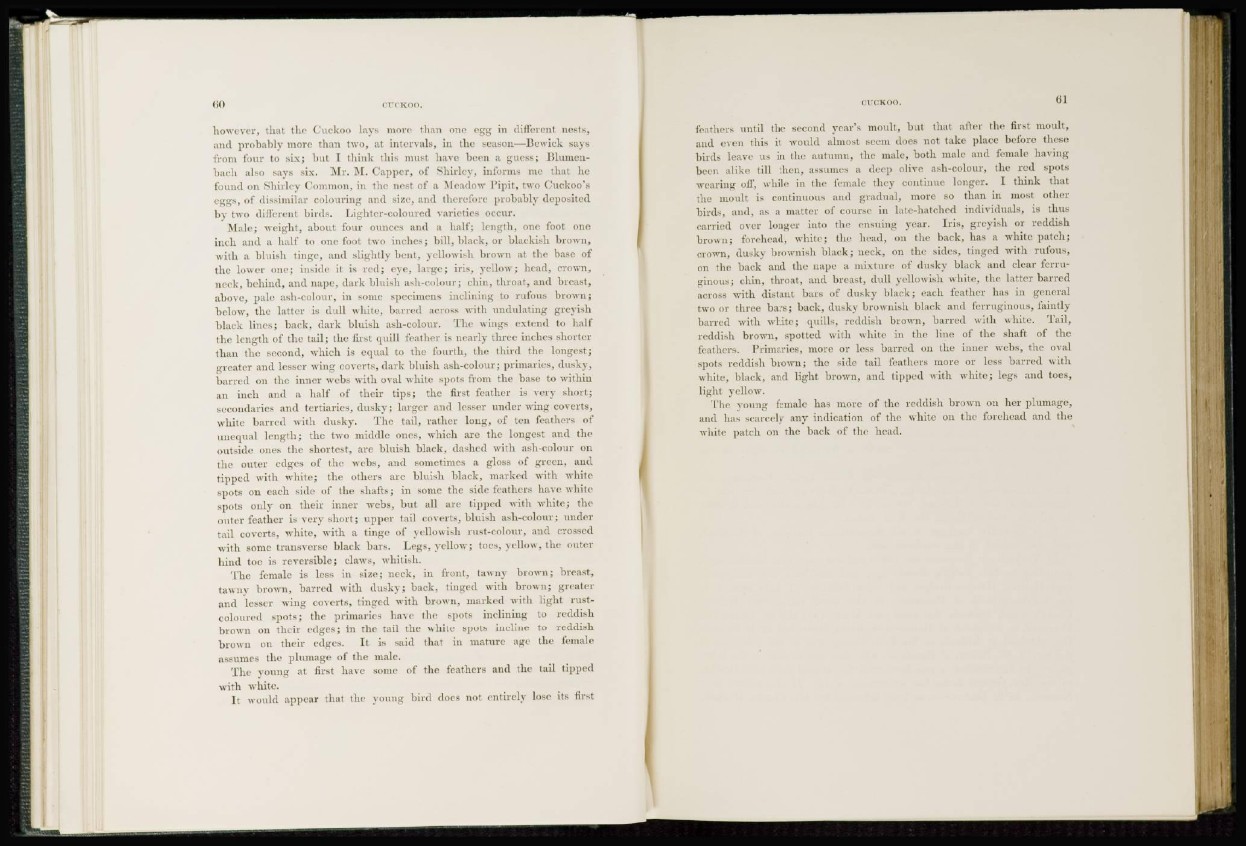
60 r r < KOO.
however, that the Cuckoo lays more than one egg in different nests,
and probably more than two, at intervals, in the season—Bewick says
from four to six; hut I think this must have been a guess; Blumeubach
also says s i x . Mr. M. Capper, of Shirley, informs me that he
found on Shirley Common, in the nest of a Meadow Pipit, two Cuckoo's
eggs, of dissimilar colouring and size, and therefore probably deposited
by two different birds. Lighter-coloured varieties occur.
Male; weight, about four ounces and a half; length, one foot one
inch and a halt' to one foot two inches; bill, black, or blackish brown,
with a bluish tinge, and slightly bent, yellowish brown at the base of
the lower one; inside it is red; eye, large; iris, yellow; head, crown,
neck, behind, and nape, dark bluish ash-colour; chin, throat, and breast,
above, pale ash-colour, in some specimens inclining to rufous brown;
below, the latter is dull white, barred across with undulating grcvish
black lines; back, dark bluish ash-colour. The wings extend to half
the length of the tail; the firsl quill feather is nearly three inches shorter
than the second, which is equal to the fourth, the third the longest;
greater and lesser wing coverts, dark bluish ash-colour; primaries, dusky,
barred on the inner webs with oval white spots from the base to within
an inch and a half of their tips; the first feather is very short;
secondaries and tcrtiarics, dusky; larger and lesser under wing coverts,
white barred with dusky. The tail, rather long, of ten feathers of
unequal length; the two middle ones, which are the longest and the
outside ones tin; shortest, arc bluish black, dashed with ash-colour on
the outer edges of the webs, and sometimes a gloss of green, and
tipped with white; the others are bluish black, marked with white
spots on each side of the shafts; in some the side feathers have white
spots only on their inner webs, but all arc lipped with white; the
outer feather is very short; upper tail coverts, bluish ash-colour; under
tail coverts, white, with a tinge of yellowish rust-colour, and crossed
with some transverse black bars. Legs, yellow; toes, yellow, the outer
hind toe is reversible; claws, whitish.
The female is less in size; neck, in front, tawny brown; breast,
tawny brown, barred with dusky; back, tinged with brown; greater
and lesser wing coverts, tinged with brown, marked with light rustcoloured
spots; the primaries have the spots inclining to reddish
brown on their edges; in the tail the white spots incline to reddish
brown on their edges. It is said that in mature age the female
assumes the plumage of the male.
The young at first have some of the feathers and the tail tipped
with white.
It would appear that the young bird does not entirely lose its first
CUCKOO. 61
feathers until the second year's moult, but that after the first moult,
and even this it would almost seem does not take place before these
birds leave us in the autumn, the male, both male and female having
been alike till then, assumes a deep olive ash-colour, the red spots
wearing off, while in the female they continue longer. I think that
ilio moult is continuous and gradual, more so than in most other
birds, and, as a matter of course in late-hatched individuals, is thus
carried over longer into the ensuing year. Iris, greyish or reddish
brown; forehead, white; the head, on the back, has a white patch;
crown, dusky brownish black; neck, on the sides, tinged with rufous,
on the back and the nape a mixture of dusky black and clear ferruginous;
chin, throat, and breast, dull yellowish white, the latter barred
across with distant bars of dusky black; each feather has in general
two or three bars; back, dusky brownish black and ferruginous, faintly
barred with white; quills, reddish brown, barred with white. Tail,
reddish brown, spotted with white in the line of the shaft of the
feathers. Primaries, more or l e s s barred on the inner webs, the oval
s p o t - reddish brown; the side (ail feathers more or less barred with
white, black, and light brown, and tipped with white; legs and toes,
light yellow.
The young female has more of the reddish brown on her plumage,
and has scarcely any indication of the white on the forehead and the
white patch on the back of the head.